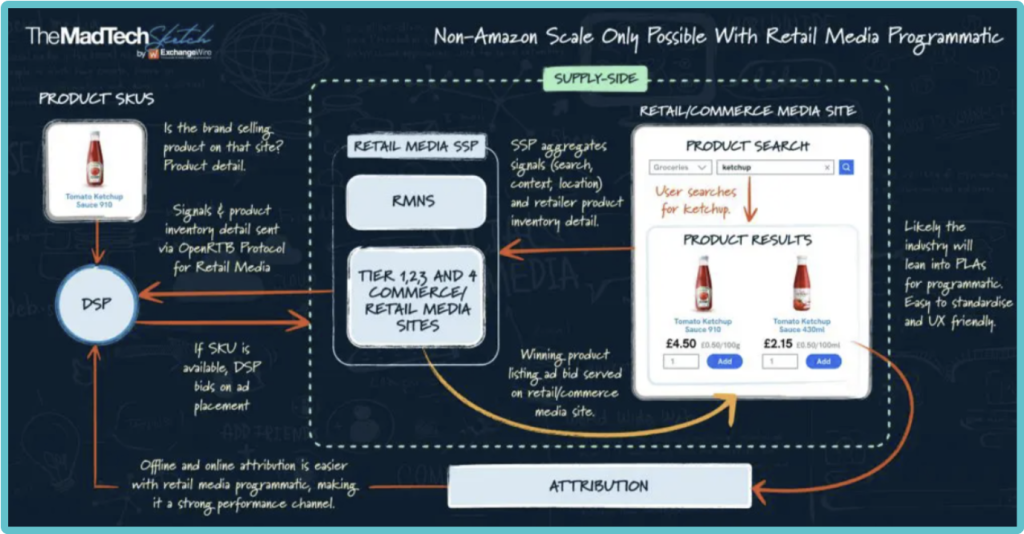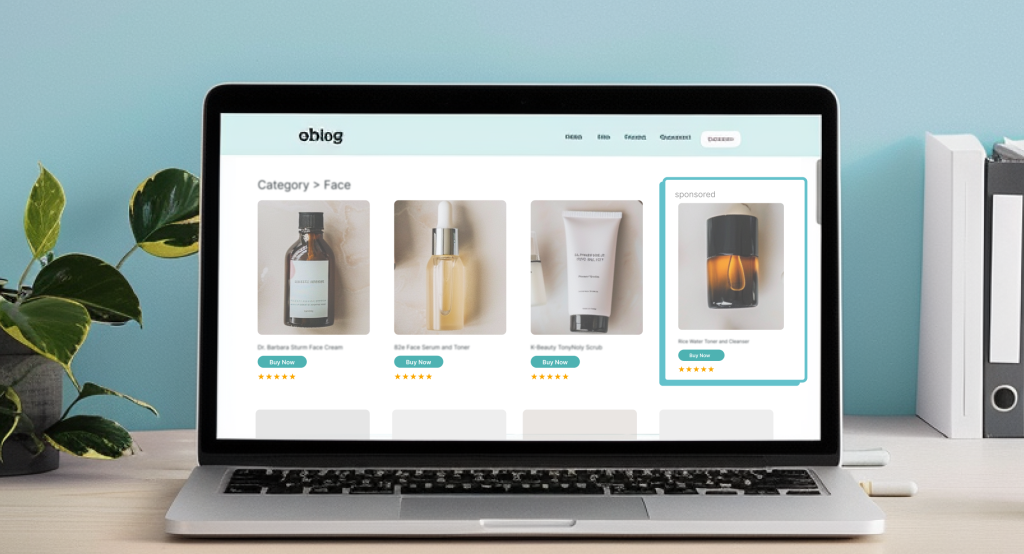The retail media industry is rapidly evolving, becoming a crucial channel for brands to reach consumers. However, the landscape has traditionally been dominated by a few major players, creating barriers to entry for smaller brands.
Democratizing retail media is essential for fostering a more inclusive and competitive market through programmatic advertising and Open Real-Time Bidding (OpenRTB). Retail Media Supply Side Platforms (SSPs), offer a pathway to achieve this democratization.
What is a Retail Media Supply-side Platform (SSP)?
Supply-side Platforms (SSP) are crucial in the programmatic ecosystem, serving as intermediaries between publishers (retailers) and ad exchanges. SSPs enable retailers to manage, sell, and optimize their ad inventory in real time.
In retail media, a Supply-Side Platform must carefully balance several key priorities to ensure a great advertising experience. It’s not just about boosting ad revenue; the SSP needs to protect the customer experience by showing the most relevant sponsored product ads without disrupting shopping.

It also must follow the retailer’s rules and requirements, from brand safety to inventory management. By using advanced technology and real-time data, a retail media SSP can deliver personalized and compliant ads that meet the retailer’s goals and keep customers happy.
SSPs can also help retailers maximize revenue by ensuring that ad space is sold to the highest bidder efficiently and transparently.
This technology can facilitate access to a wider range of advertisers, increasing competition and driving up the value of ad placements. This allows smaller brands to access premium ad spaces that were previously dominated by larger players, fostering a more level playing field.
Greater Reach and Relevance with Programmatic Advertising
Programmatic advertising in retail media automates the buying and selling of sponsored product ads inventory through real-time bidding processes. This approach enhances efficiency, allowing for scalable and automated ad transactions.
By integrating programmatic solutions, brands can achieve greater reach and relevance in their advertising efforts. The use of data and technology in programmatic advertising ensures that ads are more targeted and personalized, improving the overall consumer experience.

Source: TheMadTechSketch by ExchangeWire
“The road to achieving non-Amazon scale in the retail arena necessitates a concerted embrace of programmatic retail media. By leveraging the power of PRM, industry players stand poised to revolutionize their advertising strategies, driving unprecedented growth and success in the ever-competitive retail landscape.”

What We Can Learn from Programmatic:
1. Enhanced Consumer Experience: Programmatic advertising enables personalized ad delivery, making ads more relevant to consumers’ interests and behaviors. This not only improves engagement but also enhances the overall shopping experience.
2. Accessibility for Smaller Brands: Democratizing the industry through the adoption of programmatic retail media standards and introduction of SSPs lowers the barriers to entry for smaller brands. They can compete with larger players by leveraging the same advanced technologies and data-driven insights.
3. Standardization and Transparency: OpenRTB promotes standardization and transparency in ad transactions. This reduces the complexity and opaqueness of the bidding process, ensuring fairer competition and more informed decision-making.
4. Increased Competition and Innovation: A democratized retail media landscape encourages more competition, leading to greater innovation and better services for both brands and consumers. SSPs facilitate this by providing a platform where all brands can compete equally for ad placements.
So…Do I Need a Retail Media SSP?
Whether you already have a sponsored product program in place or are looking to get started, if these are your goals, you should consider evaluating a Retail Media SSP:
1. Improve sponsored product ad relevancy, click-through rates and conversion rates
2. Manage, sell and optimize on-site ad inventory
3. Connect multiple ad networks and DSPs
When you can deliver your ads that are relevant and dynamic as your organic products—then you can improve conversion rates, scale up on-site inventory. Then, you can increase demand with more advertisers and can expect topline results like our clients have seen:
- 90% increase in revenue
- 152% increase in ads per request
- 52% increase in CTR
- 283% increase in total ad revenue
Source: Fluid inventory expansion test results with a Top-20 US Retail Media Network 2023
“Retail Media’s aim is to offer a more personalized and relevant journey from discovery to purchase for our customers. With standardization and simplification of protocols adapted for on-site product listing ads, we’re able to preserve that experience while increasing product visibility and discovery across various customer touch points.”

Future Prospects
The future of retail media lies in continued advancements in programmatic technologies and the establishment of industry-wide standards. The Interactive Advertising Bureau (IAB) plays a critical role in this by promoting the adoption of OpenRTB and other programmatic standards. As the industry evolves, we can expect more innovations that further democratize retail media, making it accessible to brands of all sizes and enhancing the consumer experience.
“Looking to the future, the IAB is committed to establishing a set of standards that are not only robust and responsive, but also adaptive to the evolving retail media sector. Its goal is to empower retailers and brands with the tools they need to thrive in a competitive digital marketplace.”

Conclusion
Democratizing the retail media industry is vital for fostering a competitive and inclusive market. Programmatic retail media, driven by protocols like OpenRTB and the critical role of SSPs, is key to achieving this. By embracing programmatic solutions, the retail media landscape can become more transparent, efficient, and accessible, benefiting both brands and consumers. Industry stakeholders must take proactive steps to integrate these technologies, ensuring a vibrant and dynamic future for retail media.
“When retail media networks maximize relevance and open up more supply – ideally flexibly versus fixed – this boosts product sales (the numerator) and reduces CPCs (the denominator) in the near term. That powers the flywheel by driving ad performance, which leads to more demand for both ads and products.
But the real challenge for retail media networks isn’t strategy or even technology–it’s organizational and cultural. It’s about overcoming legacy views and reframing what relevance really means (and how it’s managed). ”
With the right partner and data, sponsored products can deliver the most measurable and strongest-performing relationship between advertising and commerce in history. ”





